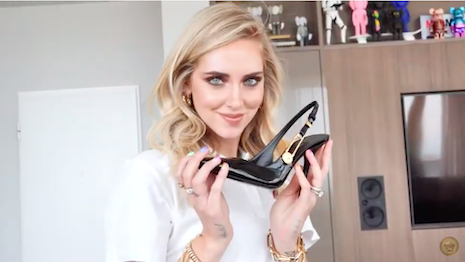 Italian model, influencer and designer Chiara Ferragni showing a look from Versace's spring/summer 2020 collection. Image credit: Versace
Italian model, influencer and designer Chiara Ferragni showing a look from Versace's spring/summer 2020 collection. Image credit: Versace
Carolina Herrera, the famed fashion designer, once said, “Luxury will always be around, no matter what happens in the world.” Well, a lot has happened in our world in this past year.
What impact has COVID-19 had on the marketing of luxury? And within influencer marketing, what changes have we seen? At Inpulsus, we have worked hard to assess the key variables and have come up with a roster of predictions for 2021.
It is no secret that the luxury business has always heavily relied on retail and been more cautious than others to adopt the new form of marketing that is influencer marketing. That said, 2020 will be marked as the year where things truly shifted.
With the postponement and cancellation of most traditional luxury marketing activities such as events and trips, all marketing activities moved online. It is clear that COVID-19, together with the racial justice movements, have strongly impacted luxury brands.
But the global health crisis has also provided them with a great opportunity to refocus on “purpose,” as luxury brands have always stood for something bigger than just selling products.
Many demonstrated purpose and empathy: Bulgari making a major donation to Italy’s Centre of Excellence in Research and Medicine to fight against the coronavirus and LVMH adapting its supply chain to produce hydroalcoholic gel, for example. These positive actions helped them remain relevant at a time where sales and marketing activities slowed to a halt. But there are other obstacles ahead.
Luxury brands continue to face the challenge of digital transformation.
While other industries have accelerated the rate of change, luxury has mainly been experimenting. Add in the natural evolution of its audiences in terms of age and location, and you have a perfect storm of both challenge and opportunity.
According to Italian luxury trade lobby Altagamma, luxury growth lies with youth and Chinese consumers in years to come. Management consultancy Bain expects that Chinese consumers will make more than half of luxury goods purchases by 2025.
Going a bit deeper, luxury brands have had to carefully balance their marketing activities to ensure that they do not alienate their older consumers at the expense of attracting a new and younger audience.
Millenials and Gen Z have very different expectations: social and mobile-first, they require new engagement strategies.
To respond to these rising segments, luxury should be less about mystery, secrecy and elitism and more about craftsmanship, social responsibility, sustainability and inclusivity.
Luxury brands will need to evolve their core digital capabilities and focus more on how their brand makes you feel, than how it makes you look. To that end, here are seven trends to anticipate in 2021:
An urgent need to bring influencer marketing in-house
Budgets will be redirected from traditional to digital marketing activities so as not to rely heavily on retail and real-life experiences. Because of this, the increase in influencer marketing investment will not only be directed to influencers themselves but to the internal practice itself.
If COVID-19 has demonstrated anything, it is the importance of having a direct relationship with influencers so as not to solely rely on external partners to reach and engage with them.
Luxury brands naturally work more strategically and more collaboratively with their different teams and offices as they are, by essence, global.
Supported by smarter influencer marketing technology services, brands will be able to better develop data-driven approaches from identification and audience insights to program management and measurement – much of this in-house.
And while some agency budgets will be cut, brands may still call on external partners for campaign concept development, for example.
Internalizing the efforts may initially shift the budgets to be front-ended, but the re-allocation will clearly end up saving them time, money and, most importantly, enabling them to be agile in a fast-changing environment.
A refocus on sustainability and craftsmanship
This year has acted as an accelerator of existing trends, and the global pandemic has highlighted environmental concerns as a higher priority for consumers.
If luxury brands have taken consumers’ trust for granted in this regard, they will need to now demonstrate their commitment. This will lead to a move from “heritage” and “legacy” in terms of content, towards a refocus on “sustainability” and “craftsmanship.”
Sustainability has already become a more important criteria when speaking about luxury brands and it can be a very powerful differentiator.
A logo on a T-shirt will not cut it anymore, and while some brands such as Stella McCartney and Icicle have built their brand on sustainability, the majority of others have barely scratched the surface.
Luxury brands should tap into the sustainable and craftsmanship angles that speak very highly to young audiences and promote a more responsible consumption of luxury. But it also means they will need to become more transparent and share more about the behind-the-scenes, which will challenge their secrecy legacy.
After decades of dictates from fast-changing trends and movements, the ever-growing #slowluxury and ethical fashion movement will challenge luxury brands to reassess their “Why?” in the 21st century.
Sustainability and environmental influencers have not only grown considerably in 2020, but they have also put pressure on brands and more established influencers to take a stand.
Luxury brands would do well to take note and engage early with these influencers, as they will not just take a check.
Rise of inclusivity
Social movements such as Black Lives Matter, #MeToo and other racial justice themes have also shaken the world in 2020.
Consumers, particularly Gen Z and millennials, want to stand for something.
Young consumers do not just expect brands to take a stand, but to act on it, which means simply including more diversity in luxury brands’ marketing will not be enough.
Luxury brands will need to adjust their strategies across staff, individuals and the organizations with whom they are teaming up.
We have all witnessed the rise of BIPOC [Black, indigenous and people of color] influencers this year and this trend will only increase in years to come.
Luxury brands will need to demonstrate more inclusivity and that they have understood that diversity is a priority for their consumers.
From macro to midsize and micro-influencers
Luxury brands have traditionally leaned towards global celebrity ambassadors.
When they first included influencer marketing as part of their mix, brands focused on retaining creative control across these macro-influencers. But over the last few years, brands have moved towards midsize influencers to reach new audiences, as these have proven very effective at creating authentic content and engaging their audiences.
The smaller influencers are truly passionate about what they do and have built incredibly engaged communities with a much higher degree of authenticity and engagement.
In a fast-changing environment, we expect luxury brands to continue tapping into midsize influencers even more but also to start experimenting with micro-influencers to reach specific audience segments.
Midsize and micro-influencers tend to be great content creators that have carved out a niche for themselves and can indirectly generate more accessibility and showcase more values, purpose and empathy for brands.
Emphasis will be given to individuals that are aligned and produce great but also complementary content, adding to the content strategy visually and in terms of storytelling.
Influencers leveraged within branded content
Until 2020, luxury brands have usually engaged influencers as a new type of journalist or celebrity. They pushed them highly controlled opportunities as an extension of their public relations activities: inviting them to catwalks; for stays in their hotels; test drives of their new car models; or unique visits to their design studios and other branded events.
Brands also relied on product launches and endorsements to incentivize influencers to share brand content within influencer channels, but very rarely on the brand's owned channels.
Now with photoshoots stalled and most creative production closed down due to lockdowns, new ways have emerged to involve influencers more as content creators.
Building relationships with these content creators will help luxury brands slowly, but surely, let go of the restrictive creative control that they have historically exercised.
Some luxury brands have also started to collaborate with these content creators to create new branded content, which is a great way to keep creative control intact while the content created is also shared on the influencer’s channels.
This is a fantastic way for luxury brands to associate with these content creators more deeply and reward them for their craft rather than just endorsement. We expect more of these types of collaborations in the future.
More competition from independent luxury brands
Luxury brands have benefited from being attractive to influencers, but now influencers are becoming more independent from brand deals alone, developing their own merchandising, at times their own brands, launching subscriptions models for their audiences to access deeper content, et al.
A growing number of small, independent and sustainable luxury brands that do not have old histories are seeking relevant influencers to appear more human, authentic, transparent via creative and inspiring storytelling.
These brands generally provide better quality at a lower price, as they tend not to rely on a logo, and have less issues sharing relevant content on their own channels. This offers a great opportunity for user-generated content and customer advocacy.
This is not a new trend in some luxury markets.
In the drink sector, small independent brands have generated more genuine interest from mixologists rather than the large drinks brands.
Indeed, audiences tend to highly value the discovery factor: key influencers have now been labelled as the new retailers by one of the most iconic fashion magazines.
When only five years ago, luxury brands just had to ask for influencers to team up with them, brands can expect more competition and scrutiny from sought-after influencers.
The emergence of these small labels is expected to accelerate in 2021. If your brand values do not align with those of the influencer, do not expect them to work with you.
Instagram will remain the dominant platform
While TikTok will continue to generate interest and drive higher spend in particular to attract and engage the Chinese market and Gen Z, Instagram will remain the dominant platform for luxury brands.
Instagram offers a huge number of possibilities for content creation: the Feed and IGTV are the perfect places for luxury brands to maintain creative control, while Stories and Reels are best for user-generated content and influencer content sharing and audience creation.
The Stories swipe-up feature and Instagram Shopping is a made-in-heaven marriage for retail brands and influencers alike. And now with Instagram Checkout, a two-tap streamlined purchase process all in the app, it will be difficult for other platforms to compete.
For influencers, the possibility to drive sales through Checkout and the upcoming rollout of Shopping from Creators provides an unrivaled opportunity, making it easier for brands to track their influencer marketing results.
THIS YEAR HAS clearly exposed the challenges ahead for luxury brands and they go well and beyond marketing.
In 2021, luxury brands will heavily invest in strategic influence marketing and build and nurture influential communities founded on tiered-approaches and key archetypes across the customer journey and the organization as a whole.
Influence strategies will not only help luxury brands to digitally enable audiences, but they will help them to redefine themselves, find innovative solutions and generate insights to remain relevant and agile.
 Delphine Reynaud
Delphine Reynaud
Delphine Reynaud is partner at Inpulsus, Paris.
